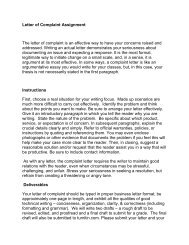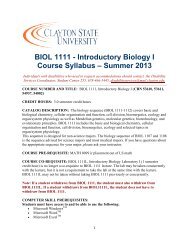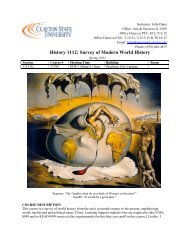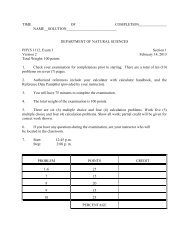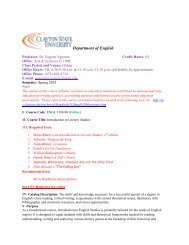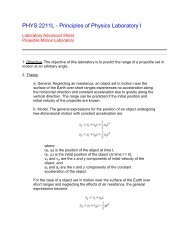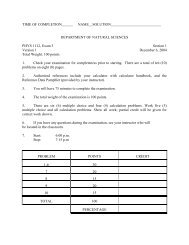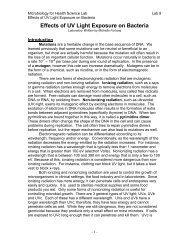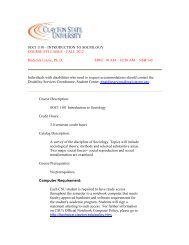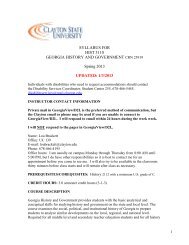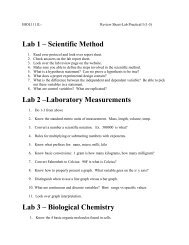Introduction to Mathematical Modeling - Faculty > Home - Clayton ...
Introduction to Mathematical Modeling - Faculty > Home - Clayton ...
Introduction to Mathematical Modeling - Faculty > Home - Clayton ...
Create successful ePaper yourself
Turn your PDF publications into a flip-book with our unique Google optimized e-Paper software.
MATH 1101Fall 2012 Syllabus<strong>Introduction</strong> <strong>to</strong> <strong>Mathematical</strong> <strong>Modeling</strong>NOTE: Please read this syllabus carefully. You are responsible for any information given here aswell as any modification or announcements given in class by your instruc<strong>to</strong>r.Prerequisites: Math 0099 or high school Algebra II and a suitable score on a mathematicsplacement test.Learning Outcomes: After successful completion of the course the student will be able <strong>to</strong>:1. Model situations from a variety of settings in mathematical forms by extracting quantitativedata from a given situation, translating the data in<strong>to</strong> information in various modes, evaluatingthe information , abstracting essential information, making logical deductions, and arriving atreasonable conclusions;2. Manipulate mathematical information, concepts, and thoughts in verbal, numeric, graphical andsymbolic form while solving a variety of problems;3. Solve multiple-step problems through different (inductive, deductive and symbolic) modes ofreasoning;4. Express mathematical information , concepts, and thoughts in verbal, numeric, graphical andsymbolic form while solving a variety of problems;5. Shift among the verbal, numeric, graphical and symbolic modes of considering relationships;6. Use appropriate technology in the evaluation, analysis, and synthesis of information inproblem-solving situations.Course Description: This course is a study of equations, functions, graphs, modeling, and problemsolving. Linear, quadratic, exponential, and logarithmic equations in one variable are applied <strong>to</strong> avariety of problems, which concern real-world situations. Systems of linear equations in twovariables are studied in conjunction with their use in problem solving. The concepts of functionsand graphing are studied as essential <strong>to</strong>ols for interpreting functions of one variable. Linear,quadratic, exponential, polynomial and logarithmic functions are emphasized and used <strong>to</strong> model avariety of real-world situations.Outcomes:Communication: Students will gain a knowledge base of basic mathematics in analytical,graphical, and numerical form. Students will communicate their ideas orally in class discussionsand in written form on quizzes and examinations.Critical Thinking: Students will apply their knowledge <strong>to</strong> solve applied problems presented inclass, on quizzes, and on examinations. Students will determine the mathematical question andappropriate concepts with which <strong>to</strong> draw a conclusion, and then provide evidence of a logicalanswer.
Course Materials: The following materials are required and should be brought <strong>to</strong> every classmeeting.Computer (required): A computer is required in Math 1101. Each student in Math 1101 needsaccess <strong>to</strong> a notebook computer. Students will use their notebook computers during class sessionsand tests. Clay<strong>to</strong>n State University requires that students have ready access throughout the semester<strong>to</strong> a notebook computer that meets faculty-approved hardware and software requirements for thestudent's academic program. See http://itpchoice.clay<strong>to</strong>n.edu for full details of this policy. It is astudent’s responsibility <strong>to</strong> have a working computer. Please keep your instruc<strong>to</strong>r updated if you arehaving computer problems. In most cases, if your computer is not working properly, you can seesomeone in the HUB or contact a software help center.Math Software (required): The software package that the mathematics faculty will be using inMath 1101 is Graph. Graph is a free package, downloadable from http://www.padowan.dk/graph/.Follow the download and installation instructions on the indicated web site.Textbook and MyMathLab Access (required):Ronald Harshbarger & Lisa Yocco College Algebra in Context, Fourth edition, Pearson Education,Inc., 2013. New textbooks are shrink-wrapped with a MyMathLab.com access code. MyMathLabis an online course resource, homework tu<strong>to</strong>rial, and testing center. Students are required <strong>to</strong> useMyMathLab.com in this course. Purchasers of used textbooks can purchase a stand-aloneMyMathLab Starter Kit in the CSU books<strong>to</strong>re which includes the access code or, buy the codeonline at https://pearsonmylabandmastering.com/students/register/#page=home with a credit cardAND the course ID. This course ID will be provided as soon as it is available. You will not beallowed <strong>to</strong> register for MML until you have both, the course ID and the purchased access code.You will be required <strong>to</strong> use MML <strong>to</strong> complete online homework and quizzes, but access will alsomake available many online resources found at this website. Follow the instructions provided withthe access code <strong>to</strong> set up your computer <strong>to</strong> access these resources. Once you have accessed MMLyou will need <strong>to</strong> go through the Installation Wizard in order <strong>to</strong> install all software plug-insnecessary for the system <strong>to</strong> operate properly on your machine.You should bring your computer and textbook <strong>to</strong> each class meeting.Thank you for turning off your cell phones during lecture and exams!Course Content:Functions, Graphs, and Models; Linear Functions: Functions and Models, Graphs of Functions,Linear Functions, Equations of Lines.(Sections 1.1 – 1.4)
Linear Models, Equations , and Inequalities: Algebraic and Graphical Solutions of LinearEquations, Fitting Lines <strong>to</strong> Data Points: <strong>Modeling</strong> Linear Functions, Systems of Linear Equationsin Two Variables, Solutions of Linear Inequalities.(Sections 2.1 - 2.4)Quadratic Piecewise-Defined, and Power Functions: Quadratic Functions; Parabolas, SolvingQuadratic Equations, Piecewise-Defined Functions and Power Functions, Quadratic and PowerModels.(Sections 3.1 - 3.4)Additional Topics with Functions: Transformations of Graphs and Symmetry, CombiningFunctions; Composite Functions, One-<strong>to</strong>-One and Inverse Functions.(Sections 4.1 – 4.3)Exponential and Logarithmic Functions: Exponential Functions, Logarithmic Functions;Properties of Logarithms, Exponential and Logarithmic Equations, Exponential and LogarithmicModels, Exponential Functions and Investing. (Sections 5.1 - 5.5)Higher-Degree Polynomial and Rational Functions: Higher Degree Polynomial Functions,<strong>Modeling</strong> with Cubic and Quartic Functions, Solution of Polynomial Equations.(Sections 6.1 - 6.3)University Policies:See the current online Academic Catalog at http://publications.clay<strong>to</strong>n.edu/catalog/ for details onthe following policies.No Shows: Any paid student who has failed <strong>to</strong> attend a class by the deadline posted in the officialuniversity calendar for the term will be identified as a “no show.” The “no show” student will beadministratively withdrawn from the class, a grade of W$ will be posted, and the student will NOTbe reinstated. Any appeals on the decision are made <strong>to</strong> the Dean of the student’s major.Three-Attempts: A student who has withdrawn or earned a less-than-satisfac<strong>to</strong>ry grade (viz. F, U,D, WF, or W) a <strong>to</strong>tal of three times in a course at CSU will not be allowed <strong>to</strong> take the course again.Any appeals on the decision must be made <strong>to</strong> the Dean of the student’s major.Midterm Grades: All students of MATH 1101 will be issued a midterm grade by Oc<strong>to</strong>ber 3, 2012.This midterm grade will reflect approximately 33% of the entire course grade. Based on thismidterm grade, a student may choose <strong>to</strong> withdraw from the course and receive a grade of W. Anystudent who wishes <strong>to</strong> pursue this option must withdraw no later than Oc<strong>to</strong>ber 5, 2012.Student Conduct: For the health, safety and general well-being of all students, faculty, and staff,students must abide by the policies set forth in both the Clay<strong>to</strong>n State University Handbook(http://www.clay<strong>to</strong>n.edu/Portals/46/docs/student-handbook.pdf ) and the Basic Undergraduate
Student Responsibilities as listed in the current CSU Academic Catalog,http://publications.clay<strong>to</strong>n.edu/catalog/ .Academic Integrity: Students are expected <strong>to</strong> do their own work on all graded material for MATH1101 including quizzes, tests, and the final exam, as outlined in the Clay<strong>to</strong>n State UniversityStudent Code of Conduct, which can be found in the Student Handbook. Cheating will not be<strong>to</strong>lerated in MATH 1101, and any student who engages in suspicious conduct will be confrontedand subjected <strong>to</strong> the disciplinary process. Cheaters will, at a minimum, receive a failing grade onthe quiz, test, or exam, which could result in a failing grade in the entire course.Attendance: Students are expected <strong>to</strong> attend each class meeting. Students are responsible forknowing about in-class announcements whether they are present or not. Please consult yourinstruc<strong>to</strong>r’s class policies for specific attendance requirements for your individual section.EvaluationYour grade in MATH 1101 is dependent on the following four criteria.Online <strong>Home</strong>work / In-class Assignments and Quizzes: Your homework grade in this category,up <strong>to</strong> 100 points, will be determined by the average score that you earn on the best 21/23MyMathLab homework assignments (Your lowest two MML homework grades will be dropped.This includes scores of zero for incomplete or late assignments) and / or by the points (up <strong>to</strong> 100)that you earn on other assignments determined by your instruc<strong>to</strong>r. You should make every effort <strong>to</strong>complete the homework assignments and seek help during office hours with problems you have notbeen able <strong>to</strong> solve. Beginning with the second section of each chapter, you must score at least 60%on a particular homework before being allowed <strong>to</strong> work on the next section’s homework. Forexample, there is no pre-requisite <strong>to</strong> section 1.1, 2.1, etc. but you must score at least 60% on 1.1 <strong>to</strong>be allowed <strong>to</strong> work on homework 1.2 and so on. Reading the sections of the textbookcorresponding <strong>to</strong> the assigned homework exercises is considered part of the homework assignment;you are responsible for material in the assigned reading whether or not it is discussed in the lecture.It will be expected that you read the assigned material in advance of each lecture. MyMathLabhomework is not timed and you are allowed unlimited attempts up <strong>to</strong> the due date. <strong>Home</strong>work duedates are set as a pacing guide. However, homework can be attempted after the due date. Pleaseconsult your instruc<strong>to</strong>r’s class policies for other homework or in-class quiz details.Quizzes: Your quiz grade in this course will be determined by the best 10/12 departmentalMyMathLab quizzes. (Your lowest two quiz grades will be dropped. This includes scores of zerofor incomplete or late quizzes.) MyMathLab quizzes have a limited number of attempts and have atime limit. Quizzes must be completed by the due date and time.Tests: There will be three or four tests worth a <strong>to</strong>tal of 400 points. Consult your instruc<strong>to</strong>r’s classpolicies for tentative test dates and times.
Make-ups: It is your responsibility <strong>to</strong> make sure that you have no schedule conflicts and can takethe tests at the times designated by your instruc<strong>to</strong>r. Please consult your instruc<strong>to</strong>r’s class policiesfor any make-up policies specific <strong>to</strong> your class section. If no specific make-up policies are giventhe following rule will be in effect:There will be no early or makeup tests given. If you miss a test for any reason, your course gradewill be computed with a zero for the missed test.Final Exam: The Departmental Final Examination is comprehensive and is worth 150 points. Nostudent will be excused from taking the Final Examination, and only under unusual circumstanceswill a student be allowed <strong>to</strong> take the Final Examination at any time other than the regularlyscheduled time. Failure <strong>to</strong> take the Final Examination will result in the grade of "F” for the course.Assessment Points:AssessmentPoint Value<strong>Home</strong>work and/or in-class assignments and quizzes 100Quizzes 1003 or 4 Tests 400Final Exam 150Total 750Final Course Grade: Your course grade will be determined by the following Grading Scale.Student ResourcesGrade Percent PointsA 89.5% - 100% 672 - 750B 79.5% - 89.4% 597 – 671C 69.5% - 79.4% 522 – 596D 59.5% - 69.4% 447 – 521F < 59.5% < 447* Remember that MyMathLab is a good resource for video lectures and help with completinghomework problems.Instruc<strong>to</strong>r Office Hours: Your instruc<strong>to</strong>r holds regular office hours and is willing <strong>to</strong> help. If youare unable <strong>to</strong> make it <strong>to</strong> your instruc<strong>to</strong>r's regular office hours, please contact them by email orphone <strong>to</strong> see if another time is available.
Center for Academic Success: The Center for Academic Success (CAS) is located in the lowerlevel of the Library Building and is typically open Monday through Thursday from 8:00 a.m. – 8:00p.m. and on Friday from 8:00 a.m. – 5:00 p.m.The Center for Academic Success (CAS) provides tu<strong>to</strong>ring for this course. Appointments can bemade through Tu<strong>to</strong>rTrac at http://tu<strong>to</strong>ring.clay<strong>to</strong>n.edu or by contacting the CAS at (678) 466-4070,lower level of the library.If a student needs more extensive help than an instruc<strong>to</strong>r can provide during office hours, thestudent should investigate the resources available in the CAS. Specifically,• A student may obtain assistance with mathematics problems from personnel in the CAS forbrief periods of time. Appointments should be made in advance.• A student may obtain assistance from a peer tu<strong>to</strong>r. Appointments must be made in advance.• A student may use materials in the CAS. Among the available materials are: Videotapes,CD’s, and computer software which cover various mathematics <strong>to</strong>pics.For more information and specific details about the Center for Academic Success and on some ofthese resources, check the Center for Academic Success web page, http://www.clay<strong>to</strong>n.edu/cas .Operation Study: At Clay<strong>to</strong>n State University, we expect and support high motivation andacademic achievement. Look for Operation Study activities and programs this semester that aredesigned <strong>to</strong> enhance your academic success such as study sessions, study breaks, workshops, andopportunities <strong>to</strong> earn Study Bucks (for use in the University Books<strong>to</strong>re) and other items.Teacher Education Policy: The content of this course syllabus correlates <strong>to</strong> educationstandards established by national and state education governing agencies, accreditingagencies and learned society/ professional education associations. Please refer <strong>to</strong> the coursecorrelation matrices located at the following web sitehttp://www.clay<strong>to</strong>n.edu/arts-sciences/teachered/standardsoutcomesConceptual Framework:The mission of the Teacher Education Unit is <strong>to</strong> prepare professional educa<strong>to</strong>rs who engage inreflective practice and who are competent, caring, committed, collaborative, culturally responsive,and prepared <strong>to</strong> teach diverse learners in an ever-changing society. For the complete CSU TeacherEducation Unit Conceptual Framework, follow the link below.
Students with Disabilities: Students with disabilities who require reasonable accommodationsneed <strong>to</strong> register with Disability Services (DS) in order <strong>to</strong> obtain their accommodations. The Officeof Disability Services is located in the Student Center Building, Rooms 255 – 264, phone 678-466-5445, email disabilityservices@clay<strong>to</strong>n.edu. For more information on services offered check theweb site: http://adminservices.clay<strong>to</strong>n.edu/disability/ .Counseling and Career ServicesStudents may obtain help with education, career, and personal concerns from a staff of counselors.Its services may be of help <strong>to</strong> students with test anxiety or other problems that limit academicsuccess.For more information on services offered by Counseling Services and Career Services,check the web pages, http://adminservices.clay<strong>to</strong>n.edu/counseling/ andhttp://adminservices.clay<strong>to</strong>n.edu/career/ .TechnologyTechnology Prerequisite: The computer is used extensively in Math 1101. You should bringyour computer and textbook <strong>to</strong> each class meeting. Basic computer skills for using email, theInternet, and file management are necessary <strong>to</strong> succeed in Math 1101. If you do not have theseskills, it is strongly recommended that you attend appropriate workshop(s) provided by the StudentSoftware Support Services (SSSS) located downstairs in the Library. The URL for the SSSSWorkshops is http://thehub.clay<strong>to</strong>n.edu/index.php?nav=calendar SSSS also provides individualassistance by appointment with the receptionist or walkup basis. Students should make anappointment with the HUB <strong>to</strong> have software loaded on their computers. Please see the HUB guideabout setting up student email at http://thehub.clay<strong>to</strong>n.edu/index.php?nav=hub_guides if you needhelp with this.Technology Etiquette: The computer is used extensively in this course. When you come in<strong>to</strong> classyou should immediately set up your computer, unless otherwise informed by your instruc<strong>to</strong>r. Youare not allowed <strong>to</strong> connect <strong>to</strong> the Internet. During class do not play computer games, play music onthe computer, surf the net, pass e-mail \notes", use computer headphones, or use the computer inany way that is distracting <strong>to</strong> the instruc<strong>to</strong>r or any other student. Set the volume on your computer<strong>to</strong> a low setting. Outside of class, any e-mail sent <strong>to</strong> your instruc<strong>to</strong>r should state your name andidentify the class you are taking. Remember <strong>to</strong> act professionally when sending e-mail <strong>to</strong> yourinstruc<strong>to</strong>r. Any unprofessional e-mail sent <strong>to</strong> an instruc<strong>to</strong>r will not be <strong>to</strong>lerated.
Important Dates for the Fall 2012 :Sat, August 11Mon, August 13Mon, Aug 13 – Thurs, Aug 22Thurs, Aug 16Thurs, Aug 23Sat, Sept 1 – Tues, Sept 4Tues, Sept 18 – Tues, Oct 2Fri, Oct 5Sat, Dec 1 – Fri, Dec 7Tues, Dec 11 9:00 amFirst day of weekend classesFirst day of weekday classesDrop/AddFinal Fee Payment DeadlineNo-Show DeadlineHoliday – No classesMid-term grade Reporting PeriodLast Day <strong>to</strong> Withdraw and Receive a WFinal Exams<strong>Faculty</strong> Grade Submission DeadlineSee CSU Academic Calendar (http://www.clay<strong>to</strong>n.edu/calendar ) for the most recent academic calendarfor the Fall 2012 semester.Disruptive Classroom Behavior 1Disruptive behavior in the classroom can negatively effect the classroom environment as well as the educationalexperience for students enrolled in the course. Disruptive behavior is defined as any behaviors that hamper the abilityof instruc<strong>to</strong>rs <strong>to</strong> teach or students <strong>to</strong> learn. Common examples of disruptive behaviors include, but are not limited <strong>to</strong>:• Eating in class• Monopolizing classroom discussions• Failing <strong>to</strong> respect the rights of other students <strong>to</strong> express their viewpoints• Talking when the instruc<strong>to</strong>r or others are speaking• Constant questions or interruptions which interfere with the instruc<strong>to</strong>r’s presentation• Overt inattentiveness (e.g., sleeping or reading the paper in class)• Creating excessive noise• Entering the class late or leaving early• Use of pagers or cell phones in the classroom• Inordinate or inappropriate demands for time or attention• Poor personal hygiene (e.g., noticeably offensive body odor)• Refusal <strong>to</strong> comply with faculty directionStudents exhibiting these types of behaviors can expect a warning from the instruc<strong>to</strong>r or dismissal for the lesson inwhich the behavior occurs. Failure <strong>to</strong> correct such behaviors can result in dismissal from the course.More extreme examples of disruptive behavior include, but are not limited <strong>to</strong>:• Use of profanity or pejorative language• In<strong>to</strong>xication• Verbal abuse of instruc<strong>to</strong>r or other students (e.g., taunting, badgering, intimidation)• Harassment of instruc<strong>to</strong>r or other students• Threats <strong>to</strong> harm oneself or others• Physical violence
Students exhibiting these more extreme examples of disruptive behavior may be dismissed from the lesson or the entirecourse.Students dismissed from a lesson will leave the classroom immediately or may be subject <strong>to</strong> additional penalties.Dismissed students are responsible for any course material or assignments missed.Students dismissed from a course have the right <strong>to</strong> appeal the dismissal <strong>to</strong> the department head responsible for thecourse. Appeals beyond the department head may also be pursued. If no appeal is made or the appeal is unsuccessful,the student will receive a grade of WF (withdrawal – failing) regardless of the current grade in the course.Conditions attributed <strong>to</strong> physical or psychological disabilities are not considered as a legitimate excuse fordisruptive behavior.1The description of disruptive behavior and listings of examples of disruptive behavior are taken from the Web sites ofJames Mason University, the University of Delaware and Virginia Tech.



